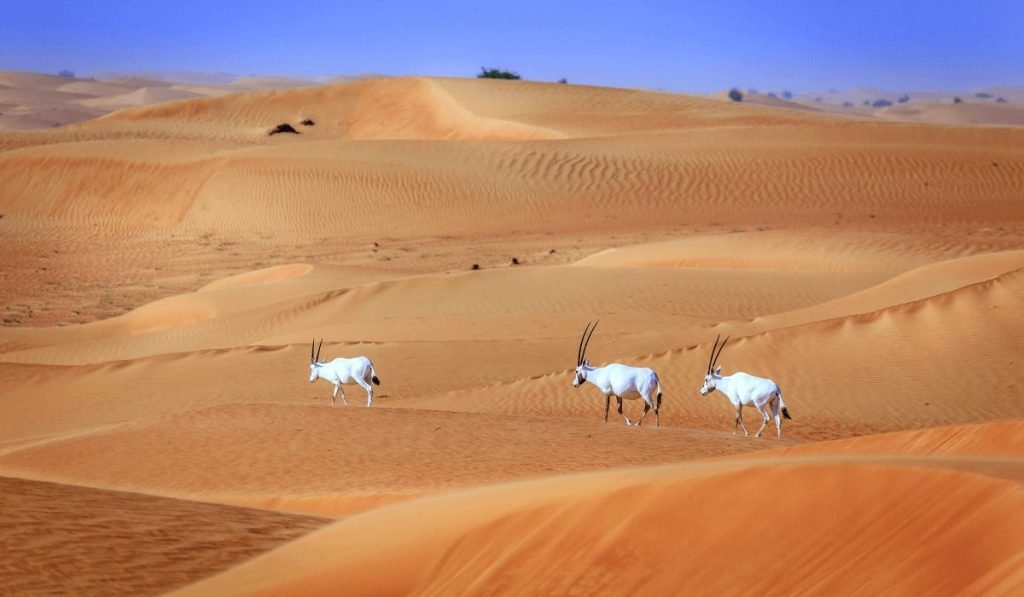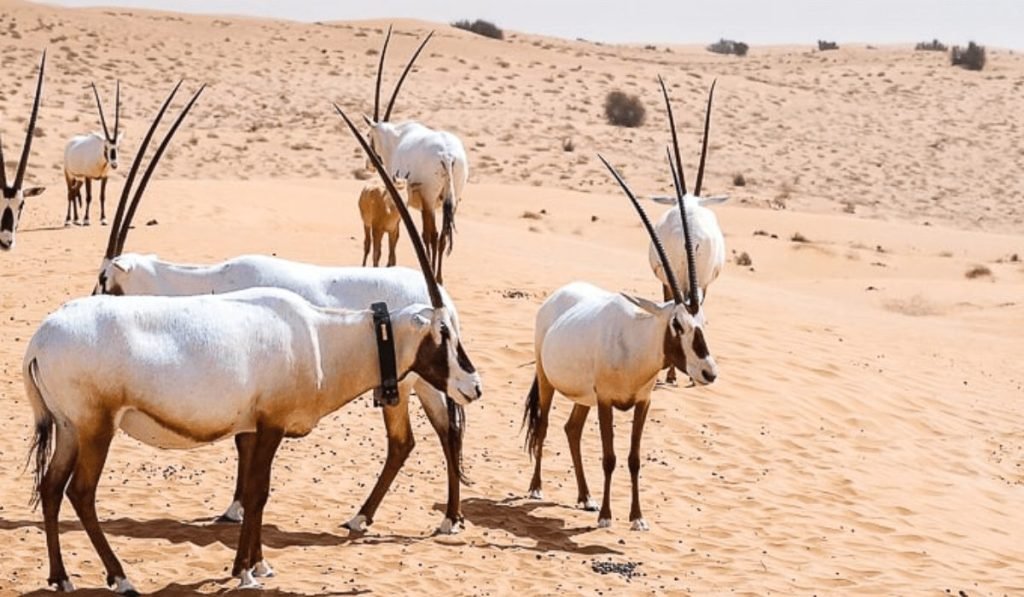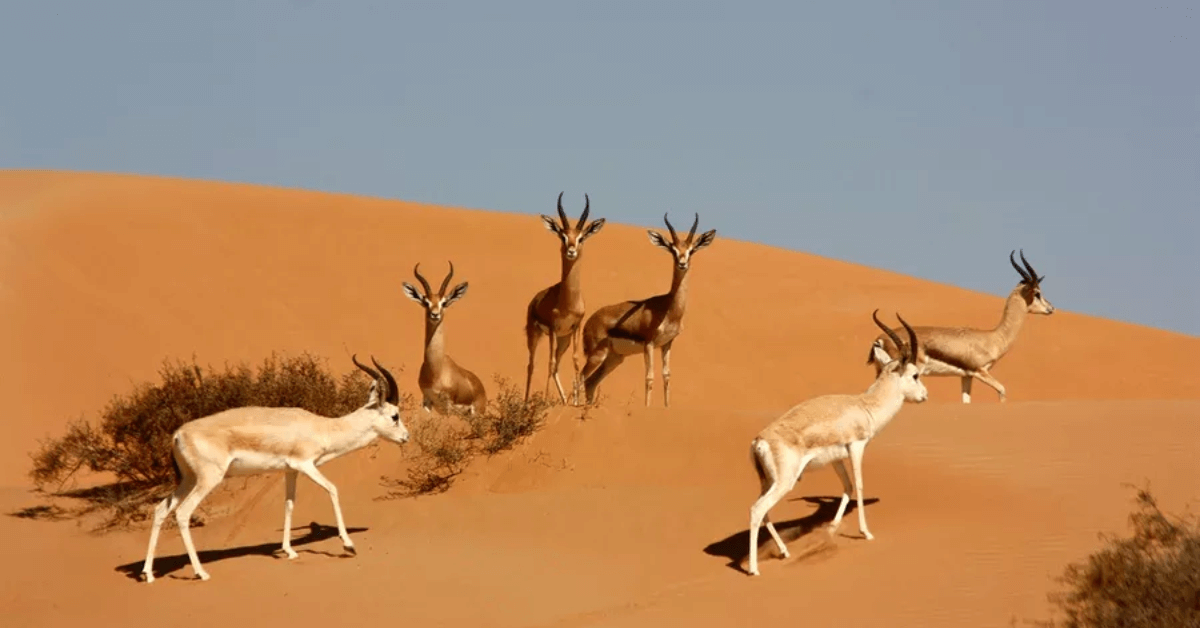Dubai, with its towering skyscrapers and modern infrastructure, is often associated with a thriving urban landscape. However, beyond the city’s bustling streets and glittering attractions lies a hidden gem—the enchanting desert landscape of Dubai. Spanning vast stretches of sandy dunes and rugged terrain, the desert offers a rich tapestry of flora and fauna that has adapted and thrived in this arid environment. In this article, we will embark on an exploration of Dubai’s desert landscape, delving into its diverse flora and fascinating fauna.
Dubai’s Desert Landscape: An Overview

Geographical Location and Climate
Situated in the Arabian Desert, Dubai’s desert landscape is part of the larger Arabian Peninsula. Bordered by the Persian Gulf to the north and vast expanses of sand to the south, the desert showcases a unique blend of coastal and inland features. The climate is characterized by scorching summers and mild winters, with limited rainfall throughout the year.
Unique Features and Challenges
The desert landscape of Dubai presents a myriad of distinctive features and challenges. The towering sand dunes, some reaching heights of over 200 meters, create an awe-inspiring sight and attract adventurers from around the world. However, these shifting sands pose difficulties for both humans and wildlife, requiring specialized skills and adaptations to navigate the terrain.
Flora of Dubai’s Desert
Native Plant Species
Contrary to popular belief, the desert is not a barren wasteland devoid of life. Dubai’s desert is home to a remarkable array of plant species that have evolved to survive in extreme aridity. Some of the notable native plants include the ghaf tree (Prosopis cineraria), which is the national tree of the United Arab Emirates, and the callosum comosum, commonly known as CIDR. These plants have developed intricate mechanisms to withstand harsh desert conditions, such as deep root systems, waxy coatings to reduce water loss, and efficient water storage capabilities.
Adaptations and Survival Mechanisms
Dubai’s desert plants have adapted ingenious strategies to thrive in the unforgiving environment. The leaves of many desert plants are reduced in size or transformed into spines, minimizing water loss through transpiration. Succulent plants like aloe vera store water in their fleshy tissues, enabling them to survive prolonged droughts. Additionally, some plants have developed unique methods of seed dispersal, utilizing the wind or attaching seeds to animals’ fur for transportation.
Fauna of Dubai’s Desert

Dubai’s desert is teeming with a surprising diversity of wildlife, each species uniquely adapted to survive in this challenging habitat.
Mammals
Despite the harsh conditions, several mammal species call the Dubai desert their home. The Arabian oryx (Oryx leucoryx), with its iconic long horns and striking white coat, is one of the most recognizable inhabitants. Other notable mammals include the sand gazelle (Gazella subgutturosa marica), the desert hedgehog (Paraechinus aethiopicus), and the sand fox (Vulpes rueppellii). These mammals have evolved to withstand extreme temperatures, conserve water, and locate food sources in the arid landscape.
Birds
Dubai’s desert is a haven for avian species, serving as a crucial stopover for migratory birds. The desert provides a habitat for various raptors, including the short-toed snake eagle (Circaetus gallicus) and the Eurasian kestrel (Falco tinnunculus). Additionally, the desert plains attract ground-dwelling birds such as the hoopoe lark (Alaemon ladies) and the cream-colored courser (Cursorius cursor), which are adapted to the sandy environment and blend seamlessly with their surroundings.
Reptiles
Reptiles have mastered survival in the Dubai desert, capitalizing on the arid conditions to thrive. The dunes are inhabited by numerous species, including the dhaba or sandfish (Scincus migrants), which can swim through the sand, and the horned viper (Cerastes cerastes), known for its unique horn-like scales and venomous bite. These reptiles possess remarkable adaptations such as heat tolerance, efficient water conservation, and camouflaging abilities.
Insects and Arachnids
Dubai’s desert is a hotbed of insect and arachnid activity. Beetles, ants, scorpions, and spiders are among the diverse invertebrates found in this ecosystem. The beetles have evolved specialized features like water-trapping exoskeletons, allowing them to survive in arid conditions. Meanwhile, scorpions and spiders have developed venomous stings and webs to catch prey and defend themselves from predators.
Conservation Efforts
Recognizing the ecological importance of Dubai’s desert landscape, conservation efforts have been implemented to protect its unique flora and fauna.
Protecting Biodiversity
Several protected areas, such as the Dubai Desert Conservation Reserve, have been established to safeguard the desert ecosystem. These reserves provide a sanctuary for endangered species and promote sustainable practices, including controlled tourism activities, scientific research, and habitat restoration initiatives. By preserving biodiversity, these efforts aim to ensure the long-term survival of Dubai’s desert ecosystem.
Sustainable Tourism and Environmental Awareness
Dubai’s desert landscape has become a popular tourist attraction, offering activities such as desert safaris and camel riding. However, steps are being taken to promote sustainable tourism practices that minimize the impact on the environment. Tour operators adhere to guidelines to protect fragile habitats, educate visitors about the importance of conservation, and support local communities. Additionally, environmental awareness campaigns raise public consciousness about the need to preserve and appreciate the natural wonders of the desert.
Conclusion
Dubai’s desert landscape is a captivating realm of extraordinary biodiversity, defying the common perception of a barren desert. From resilient plant species to elusive mammals, birds, reptiles, and insects, the fauna and flora of the desert have adapted and thrived against all odds. As we continue to explore and appreciate this remarkable ecosystem, it is essential to prioritize conservation efforts and sustainable practices. By doing so, we can ensure that future generations have the opportunity to immerse themselves in the wonders of Dubai’s desert landscape.
FAQs
Are there dangerous animals in Dubai’s desert?
While Dubai’s desert is home to various wildlife, encounters with dangerous animals are rare. It is important to respect the natural habitat and observe animals from a safe distance. Always follow the guidance of trained professionals when exploring the desert.
Can I visit Dubai’s desert on my own?
While it is possible to explore certain areas of the desert independently, it is recommended to join guided tours or seek assistance from experienced desert guides. They can ensure your safety, provide valuable insights, and help you navigate the terrain effectively.
Are there any restrictions on photography in the desert?
Photography is generally allowed in Dubai’s desert. However, it is advisable to respect the privacy of wildlife and refrain from disturbing their natural behavior. Some areas may have specific guidelines, so it’s important to follow any rules or regulations in place.
What is the best time of year to visit Dubai’s desert for wildlife sightings?
The best time to spot wildlife in Dubai’s desert is during the cooler months, from October to March. During this period, temperatures are more comfortable, and animal activity increases. However, it’s important to check the weather conditions and consult with local experts for the most accurate information.

